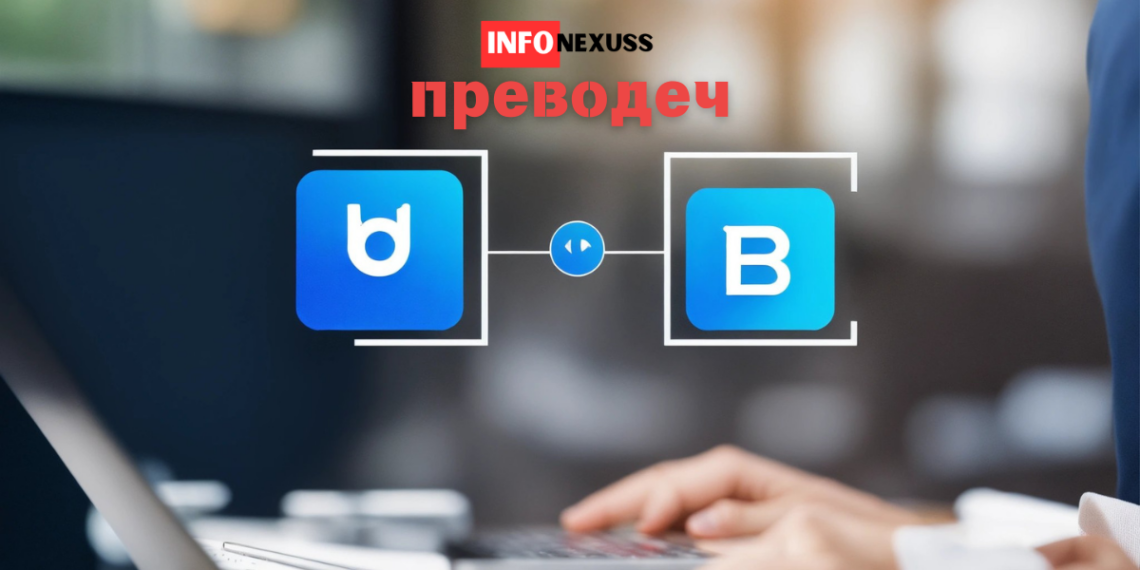
Преводеч: The Power of Translation in the Digital Age
Imagine a tool that could seamlessly bridge communication gaps, enhance global collaboration, and streamline complex processes across various industries. A single word encapsulates this powerful tool: “преводеч.” In our rapidly globalizing, digitally connected world, the demand for effective translation and communication solutions is paramount. “Преводеч” emerges as a powerful solution to meet these needs, offering transformative capabilities that extend beyond mere language translation.
In this comprehensive guide, we delve into the essence of “преводеч,” exploring its origins, applications, and significance in today’s world. Our aim is to provide you with an in-depth, user-friendly resource that not only explains what “преводеч” is but also illustrates its impact and potential. Whether you are a business professional, a technology enthusiast, or someone curious about the future of communication, this article will equip you with the knowledge to understand and leverage “преводеч” effectively.
Table of Contents
What is Преводеч?
“Преводеч” originates from the Bulgarian word for “translation,” representing the process of converting text or speech between languages. However, “преводеч” goes beyond traditional translation; it encompasses a broad spectrum of language services, including localization, interpretation, and cultural adaptation. This term signifies not just the technical process of translation but also the nuanced understanding and conveyance of context, tone, and cultural subtleties.
In an era marked by rapid technological advancement and global connectivity, “преводеч” plays a pivotal role. It is relevant today because it addresses the growing demand for multilingual communication in business, education, healthcare, and entertainment. By ensuring accurate and culturally appropriate translations, “преводеч” facilitates international collaboration, enhances customer experiences, and supports the dissemination of information across linguistic barriers.
Trace the History of Преводеч
The history of “преводеч” can be traced back to ancient civilizations, where scholars and scribes undertook the arduous task of translating religious texts, literary works, and scientific treatises. With the advent of the printing press in the 15th century, translation became more accessible and widespread, paving the way for the modern translation industry. The 20th century saw significant advancements with the introduction of machine translation and computer-assisted translation tools, marking the beginning of a new era for “преводеч.”
Significant Milestones
Key milestones in the development of “преводеч” include the creation of the first machine translation systems in the 1950s, the rise of online translation services in the late 1990s, and the integration of artificial intelligence (AI) and neural networks in recent years. These advancements have significantly improved the accuracy, speed, and accessibility of translation services, making “преводеч” an indispensable tool in various fields.
Applications of Преводеч
“Преводеч” is applied in numerous fields, each benefiting from its unique capabilities:
- Business: Multinational companies use “преводеч” to communicate with clients and partners worldwide, localize marketing content, and ensure legal and regulatory compliance.
- Education: Educational institutions and e-learning platforms rely on “преводеч” to offer multilingual courses and materials, facilitating cross-cultural knowledge exchange.
- Healthcare: Medical professionals utilize “преводеч” to provide accurate patient information, translate medical records, and improve patient outcomes through clear communication.
- Entertainment: The entertainment industry employs “преводеч” to subtitle and dub films, translate books and video games, and reach a global audience.
A notable example of “преводеч” in action is the use of AI-powered translation tools by companies like Google and Microsoft. These tools have revolutionized how businesses operate across borders, enabling instant translation of documents and conversations. Another example is the localization of popular video games, which involves not just translating the text but also adapting cultural references and nuances to resonate with different audiences.
Over time, “преводеч” has evolved to incorporate cutting-edge technologies such as AI and machine learning. These advancements have led to the development of neural machine translation (NMT), which offers more accurate and contextually relevant translations. Additionally, “преводеч” has adapted to new challenges, such as real-time speech translation and the integration of translation services into various digital platforms.
The Importance of Преводеч in Modern Industries
Role in Technology, Business, and Other Key Industries
In the technology sector, “преводеч” enables the localization of software and applications, making them accessible to a global audience. In business, it supports international trade by facilitating communication and ensuring that marketing materials resonate with target audiences. Other key industries, such as healthcare and education, also benefit from “преводеч” by improving accessibility and communication.
A case study of a tech company using “преводеч” is IBM, which employs AI-powered translation tools to support its global operations. By integrating these tools into its workflow, IBM has enhanced its ability to communicate with international clients and partners, resulting in improved customer satisfaction and business outcomes.
Benefits and Advantages
The primary benefits of “преводеч” include enhanced communication, increased efficiency, and greater accessibility. By dismantling language barriers, “преводеч” facilitates seamless communication between individuals and organizations across diverse linguistic backgrounds.
Enhanced Efficiency, Productivity, and Innovation
“Преводеч” enhances efficiency by automating the translation process, reducing the time and effort required for manual translation. This, in turn, boosts productivity and allows businesses to focus on core activities. Furthermore, by providing accurate and culturally appropriate translations, “преводеч” fosters innovation and creativity.
Unique Advantages Over Traditional Methods
Unlike traditional translation methods, which often rely on human translators, “преводеч” leverages advanced technologies to deliver faster and more accurate results. This not only reduces costs but also ensures consistency and scalability, making it ideal for large-scale projects.
How Преводеч Works
Mechanisms and Processes
“Преводеч” functions through a combination of linguistic algorithms, machine learning models, and neural networks. The process begins with the analysis of the source text, where the system identifies linguistic patterns and contextual cues. It then uses a vast database of linguistic data to generate a translation that accurately reflects the meaning and tone of the original text.
Key Components and Processes
Key components of “преводеч” include:
- Text Analysis: The system breaks down the source text into smaller units, such as words and phrases, and analyzes their linguistic properties.
- Translation Generation: Using machine learning models, the system generates a preliminary translation based on the analyzed data.
- Post-Editing: The preliminary translation is refined and optimized to ensure accuracy and fluency.
Diagrams and Illustrations
To enhance understanding, include diagrams that illustrate the translation process, from text analysis to post-editing. These visuals can help readers grasp the complexity and efficiency of “преводеч.”
Technological Framework
“Преводеч” is powered by technologies such as natural language processing (NLP), neural machine translation (NMT), and cloud computing. These technologies enable the system to handle large volumes of text and deliver high-quality translations quickly.
Recent advancements in “преводеч” include the integration of AI-driven language models like GPT-3, which offer unprecedented accuracy and contextual understanding. Additionally, advancements in speech recognition and real-time translation have expanded the capabilities of “преводеч.”
Challenges and Solutions
Notable challenges in “преводеч” include handling idiomatic expressions and cultural nuances. Solutions to these challenges involve continuous training of AI models with diverse linguistic data and incorporating feedback from human translators to improve accuracy.
Case Studies and Real-World Examples
One example of a successful “преводеч” implementation is the use of translation tools by Netflix to subtitle and dub its content for international audiences. By leveraging advanced translation technologies, Netflix has expanded its reach and improved viewer satisfaction globally.
Problems Faced, Solutions Provided, and Outcomes Achieved
Netflix faced the challenge of ensuring accurate and culturally relevant translations for its diverse content. By employing AI-powered translation tools and human reviewers, Netflix achieved high-quality translations that resonate with viewers, leading to increased subscriber growth and engagement.
Key takeaways from these case studies include the importance of combining AI tools with human expertise to achieve optimal translation quality. Additionally, continuous improvement and adaptation to new technologies are crucial for maintaining the effectiveness of “преводеч.”
Common Challenges and Solutions
Common challenges in “преводеч” include handling complex linguistic structures and ensuring cultural sensitivity. Solutions involve ongoing training of AI models and incorporating feedback loops to refine translations continuously.
Practical Tips for Implementation
For those looking to implement “преводеч” in their organizations, practical tips include starting with small-scale projects to test the system’s capabilities, continuously training AI models with relevant data, and involving human translators for quality assurance.
Also Read: PI123: UNLOCKING THE POWER OF PI IN MATH & BEYOND
Future Trends and Predictions
Emerging trends in “преводеч” include the use of AI-driven language models for more accurate and contextually relevant translations, real-time speech translation, and the integration of translation services into various digital platforms.
New technologies such as blockchain are being explored to enhance the security and reliability of translation services. Additionally, methodologies like transfer learning are being used to improve the efficiency of training AI models.
Experts predict that “преводеч” will continue to evolve, with AI playing a central role in enhancing translation accuracy and speed. They also foresee increased adoption of real-time translation tools in various industries, further breaking down language barriers.
Potential Challenges and Solutions
Potential future challenges for “преводеч” include managing the vast diversity of languages and dialects, ensuring ethical use of AI, and addressing privacy concerns related to translation data.
Possible solutions involve developing more sophisticated AI models that can handle diverse linguistic data, establishing ethical guidelines for AI use in translation, and implementing robust data privacy measures.
Encouraging Adaptability
To stay informed and adaptable, readers are encouraged to follow industry developments, participate in relevant forums and discussions, and continuously update their knowledge and skills in translation technologies.
Conclusion
In summary, “преводеч” is a transformative tool that enhances global communication and collaboration. Its diverse applications across industries yield significant gains in efficiency, productivity, and innovation. By leveraging advanced technologies, “преводеч” delivers accurate and culturally relevant translations, making it an indispensable asset in today’s interconnected world.
Readers are encouraged to explore “преводеч” further by utilizing the resources provided in this article. Whether your goal is global business expansion or personal language enhancement, “преводеч” provides valuable solutions tailored to your specific needs. Share your experiences or ask questions in the comments to join the conversation and stay informed about the latest developments in translation technology.
You May Also Like

Airmail Shortcuts Show Folders / Hide Folders
November 20, 2024
WizzyDigital org: Your Digital Transformation Partner
May 27, 2024

